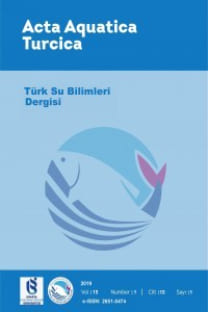Karadeniz’in Güney-doğu Kıyılarında Mezgit Balığının, Merlangius merlangus Besin Kompozisyonu
Güney-doğu Kareadeniz, Mezgit, Merlangius merlangus, Besin kompozisyonu, Kanibalizm
Food Composition of the Whiting, Merlangius merlangus in the South-eastern Coast of the Black Sea
___
- Bachok, Z., Mansor, M.İ. & Noordin, R.M. ( 2004). Diet composition and feeding habits of demersal and pelagic marine fishes from terengganu waters, east coast of peninsular Malaysia. World Fish Cent Quart, Malaysia, 27, 3-4, NAGA.
- Bradova, N., Stergiou, K.I. & Karpouzi, V.S. (2002). Feeding habits and trophic levels of Mediterranean fish. Reviews in Fish Biology and Fisheries, 11, 217-254.
- Prodanov, K. (2003). Growth rate of whing (Merlangius merlangus euxinus) from the western part of Black Sea. Bulgarian Academy of Sciences, 4, 157-164
- Bromley, P.J., Watson, T. & Hilop, J.R.G. (1997). Diel feeding patterns and the development of food webs in pelagic 0-group cod (Gadus morhua L), haddock (Melanogrammus aeglefinus L.), whiting (Merlangus merlangus L.), saithe (Pollachius virens L.) and Norway pout (Trisopterus esmarkii Nilson) in the Northern Nort Sea. ICES Journal of Marine Science, 54, 846-853.
- Cortés, E. (1997). A critical review of methods of studying fish feeding based on analysis of stomach contents: application to elasmobranch fishes. Canadian Journal of Fisheries and Aquatic Sciences, 543, 726-738
- Fox, L.R. (1975). Cannibalism in natural populations. Annual Review of Ecology, Evolution, and Systematics, 6, 87- 106.
- Hislop, J.R.G., Robb, A.P., Bell, M.A. & Armstrong, D.W. (1991). The diet and food consumption of whiting (Merlangius merlangus) in the North Sea. ICES Journal of Marine Science, 48(2), 139–156.
- Hyslop, E.J. (1980). Stomach contents analysis - a review of methods and their application. Journal of Fish Biology, 17, 411-429.
- Larger, K.F., Miller, R.R., Passino & D.R.M. (1988). Food and feeding habit of Barbus belayewii (Menon) from a Pullet River. Journal of Environmental Science and Health, 23(4), 311-320.
- Lopez-Peralta, R.H. & Arcila, C.A.T. (2002). Diet composition of fish species from southern continental shelf of Columbia. World Fish Cent Quart, 25, 23-29, NAGA.
- Mazlum, R.E. & Bilgin, S. (2014). Age, growth, reproduction and diet of the whiting, Merlangius merlangus euxinus (Nordmann, 1840), in the southeastern Black Sea. Cahiers de Biologie Marine, 55, 463-474.
- McDermott, S. & Fives, J.M. (1995). The diet of an assemblage of small demersal fish in the western Irish sea. Biology and Environment: Proceedings of The Royal Irısh Academy, 95(3), 195-201.
- Milić, D. & Kraljević, M. (2011). Biometry analysis of the whiting, Merlangius merlangus (Linneaus, 1758) from the northern Adriatic Sea. Acta Adriatica, 52(1), 125-136.
- Morte, S., Redón, M.J. & Sanz-Brau, A. (2001). Diet of Scorpaena porcus and Scorpaena notata (Pisces: Scorpaenidae) in the Western Mediterranean. Cahiers de Biologie Marine, 42, 333-344.
- Özdemir, N. (1983). Keban Baraj Gölü’nde yaşayan Barbus rajanarum mystceus (Heckel, 1843)’un bazı vücut organları arasındaki ilişkiler ve et verimi. Et ve Balık Endüstrisi Dergisi, Özel Sayı, 6.
- Ross, S.D., Nielsen, J.R., Gislason, H., Nielsen, A. & Andersen, N.G. (2018). Growth and food consumption of whiting Merlangius merlangus. Journal of Fish Biology, 93, 334-343.
- Samsun, S., Erdem, Y. & Kalaycı, F. (2011). Feeding fegime of whiting (Gadus merlangus euxinus Nordmann, 1840) in Turkish middle Black Sea coast. Turkish Journal of Fisheries and Aquatic Sciences, 11, 515-522.
- Schoener, T.W. (1970). Non-synchronous spatial overlap of lizards in patchy habitats. Ecology, 51, 1228-1250.
- Seyhan, K. (1994). Gastric emptying, food consumption and ecological impact of whiting, Merlangius merlangus (L.) in the Eastern Irish sea marine ecosystem. University College of North Wales, School of Ocean Sciences, Marine Science Laboratories, Menai Bridge, Anglesey N. Wales, United Kingdom, Doktora Tezi.
- Staniland, I.J. (1995). The feeding ecology and behaviour of whiting (Merlangius merlangus L.). Dpartment of Zoology, University of Leicester, Ph.D.Thesis.
- Stergiou, K.I. & Karpouzi, V.S. (2002). Feeding habits and trophic levels of Mediterranean fish. Reviews in Fish Biology and Fisheries, 11, 217-254.
- TOB (2020). Tarim ve Orman Bakanlığı Su Ürünleri İstatistikleri. https://www.tarimorman.gov.tr/BSGM/Belgeler/Icerikler/Su%20%C3%9Cr%C3%BCnleri%20Veri%20ve%20D%C3%B6k%C3%BCmanlar%C4%B1/Su-%C3%9Cr%C3%BCnleri-%C4%B0statistikleri.pdf
- Wallace, Jr.R.K. (1981). An Assessment of diet overlap indexes. Transactions of the American Fisheries Society, 110(1), 72-76.
- Zar, J.H. (1999). Biostatistical analysis. Prentice-Hall, Englewood Cliffs, N.J., USA
- Yayın Aralığı: 4
- Başlangıç: 1988
- Yayıncı: Yunus Ömer BOYACI
Haluk TEKEŞOĞLU, Sebahattin ERGÜN
Karadeniz’in Güney-doğu Kıyılarında Mezgit Balığının, Merlangius merlangus Besin Kompozisyonu
Farklı Baharatlar Kullanılarak Üretilen Kalamar Esaslı Atıştırmalıkların Duyusal Değerlendirmesi
Berna KILINÇ, Fevziye Nihan BULAT, Sevcan DEMİR ATALAY
Türkiye’den Metacyclops subdolus Kiefer, 1938 (Copepoda, Cyclopidae)’un İlk Kaydı
Quyet PHAN VAN, Bilgenur HARMANŞA YILMAZ, Hijran YAVUZCAN
Pınar GÜLLE, Orhan ERMAN, Yunus Ömer BOYACI
Japon Balığı (Carassius auratus) Gonad ve Viseral Organları Üzerine Bisfenol S’nin Toksik Etkileri
İkbal Demet NANE, Öznur ÖZİL, Mert MİNAZ, Mevlüt NAZIROĞLU, Öznur DİLER, Özlem ÖZMEN
Turhan KEBAPÇIOĞLU, Cenkmen R. BEĞBURS
Ebu Kefalinin Üreme Biyolojisi, Planiliza abu (Heckel, 1843), Karun Nehri, Güneybatı İran
Miaad JORFİPOUR, Yazdan KEİVANY, Fatemeh PAYKAN-HEYRATI, Zaniar GHAFOURİ
